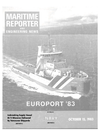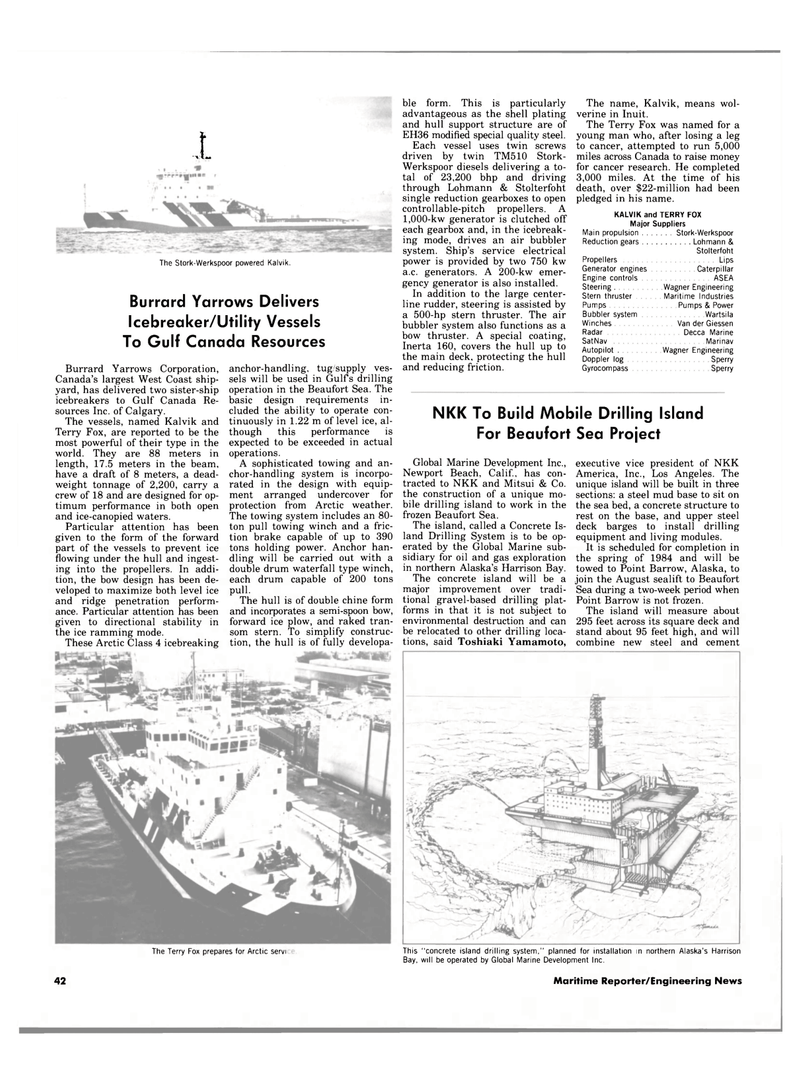
Page 44: of Maritime Reporter Magazine (October 15, 1983)
Read this page in Pdf, Flash or Html5 edition of October 15, 1983 Maritime Reporter Magazine
i
The Stork-Werkspoor powered Kalvik.
Burrard Yarrows Delivers
Icebreaker/Utility Vessels
To Gulf Canada Resources
Burrard Yarrows Corporation,
Canada's largest West Coast ship- yard, has delivered two sister-ship icebreakers to Gulf Canada Re- sources Inc. of Calgary.
The vessels, named Kalvik and
Terry Fox, are reported to be the most powerful of their type in the world. They are 88 meters in length, 17.5 meters in the beam, have a draft of 8 meters, a dead- weight tonnage of 2,200, carry a crew of 18 and are designed for op- timum performance in both open and ice-canopied waters.
Particular attention has been given to the form of the forward part of the vessels to prevent ice flowing under the hull and ingest- ing into the propellers. In addi- tion, the bow design has been de- veloped to maximize both level ice and ridge penetration perform- ance. Particular attention has been given to directional stability in the ice ramming mode.
These Arctic Class 4 icebreaking anchor-handling, tug/supply ves- sels will be used in Gulfs drilling operation in the Beaufort Sea. The basic design requirements in- cluded the ability to operate con- tinuously in 1.22 m of level ice, al- though this performance is expected to be exceeded in actual operations.
A sophisticated towing and an- chor-handling system is incorpo- rated in the design with equip- ment arranged undercover for protection from Arctic weather.
The towing system includes an 80- ton pull towing winch and a fric- tion brake capable of up to 390 tons holding power. Anchor han- dling will be carried out with a double drum waterfall type winch, each drum capable of 200 tons pull.
The hull is of double chine form and incorporates a semi-spoon bow, forward ice plow, and raked tran- som stern. To simplify construc- tion, the hull is of fully developa- ble form. This is particularly advantageous as the shell plating and hull support structure are of
EH36 modified special quality steel.
Each vessel uses twin screws driven by twin TM510 Stork-
Werkspoor diesels delivering a to- tal of 23,200 bhp and driving through Lohmann & Stolterfoht single reduction gearboxes to open controllable-pitch propellers. A 1,000-kw generator is clutched off each gearbox and, in the icebreak- ing mode, drives an air bubbler system. Ship's service electrical power is provided by two 750 kw a.c. generators. A 200-kw emer- gency generator is also installed.
In addition to the large center- line rudder, steering is assisted by a 500-hp stern thruster. The air bubbler system also functions as a bow thruster. A special coating,
Inerta 160, covers the hull up to the main deck, protecting the hull and reducing friction.
The name, Kalvik, means wol- verine in Inuit.
The Terry Fox was named for a young man who, after losing a leg to cancer, attempted to run 5,000 miles across Canada to raise money for cancer research. He completed 3,000 miles. At the time of his death, over $22-million had been pledged in his name.
KALVIK and TERRY FOX
Major Suppliers
Main propulsion Stork-Werkspoor
Reduction gears Lohmann &
Stolterfoht
Propellers Lips
Generator engines Caterpillar
Engine controls ASEA
Steering Wagner Engineering
Stern thruster Maritime Industries
Pumps Pumps & Power
Bubbler system Wartsila
Winches Van der Giessen
Radar Decca Marine
SatNav Marinav
Autopilot Wagner Engineering
Doppler log Sperry
Gyrocompass Sperr
NKK To Build Mobile Drilling Island
For Beaufort Sea Project
Global Marine Development Inc.,
Newport Beach, Calif., has con- tracted to NKK and Mitsui & Co. the construction of a unique mo- bile drilling island to work in the frozen Beaufort Sea.
The island, called a Concrete Is- land Drilling System is to be op- erated by the Global Marine sub- sidiary for oil and gas exploration in northern Alaska's Harrison Bay.
The concrete island will be a major improvement over tradi- tional gravel-based drilling plat- forms in that it is not subject to environmental destruction and can be relocated to other drilling loca- tions, said Toshiaki Yamamoto, executive vice president of NKK
America, Inc., Los Angeles. The unique island will be built in three sections: a steel mud base to sit on the sea bed, a concrete structure to rest on the base, and upper steel deck barges to install drilling equipment and living modules.
It is scheduled for completion in the spring of 1984 and will be towed to Point Barrow, Alaska, to join the August sealift to Beaufort
Sea during a two-week period when
Point Barrow is not frozen.
The island will measure about 295 feet across its square deck and stand about 95 feet high, and will combine new steel and cement
The Terry Fox prepares for Arctic servi This "concrete island drilling system," planned for installation in northern Alaska's Harrison
Bay, will be operated by Global Marine Development Inc. 42 Maritime Reporter/Engineering News

 43
43

 45
45
